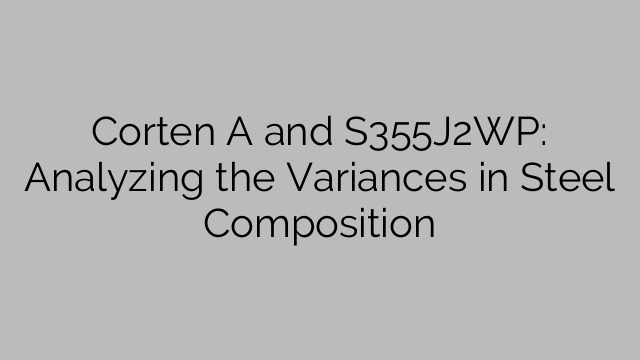Corten A and S355J2WP are two types of weathering steel that have gained popularity in various industries due to their unique properties. While both materials are commonly used for outdoor architectural and structural applications, they have noticeable differences in steel composition, which can affect their performance and suitability for specific projects.
Corten A, also known as ASTM A242 or COR-TEN A, is a type of weathering steel that contains copper, chromium, nickel, and other alloying elements. These elements enhance Corten A’s corrosion resistance, allowing it to form a protective rust-like layer when exposed to the atmosphere. This layer not only protects the steel from further corrosion but also gives it a distinctive appearance, often referred to as a “weathered” or “rusty” look. Corten A is widely used in architectural applications, such as building facades, outdoor sculptures, and bridges, as its unique aesthetics add an element of visual interest to the structures.
On the other hand, S355J2WP is a European equivalent of Corten A and is produced according to EN 10025-5:2004. S355J2WP is known for its improved atmospheric corrosion resistance compared to standard structural steels. It contains alloying elements like copper, chromium, and phosphorus that contribute to its enhanced corrosion resistance. S355J2WP is commonly used in structural applications such as bridges, pylons, and shipping containers.
One of the key differences between Corten A and S355J2WP lies in the composition of their alloying elements. Corten A contains higher amounts of copper, while S355J2WP has a higher concentration of chromium. Copper enhances the corrosion resistance of steel by promoting the formation of a protective oxide layer, while chromium acts as a barrier to prevent oxygen from reaching the steel surface. The presence of these elements contributes to the self-protecting properties of both materials, allowing them to withstand harsh weather conditions and reducing maintenance requirements.
Another difference between Corten A and S355J2WP is their mechanical properties. Corten A has a higher tensile strength and yield strength compared to S355J2WP, making it suitable for applications that require higher structural strength. On the other hand, S355J2WP exhibits better toughness and elongation properties, making it more suitable for applications where ductility is important.
Apart from their differences in steel composition and mechanical properties, Corten A and S355J2WP also have variations in their manufacturing processes. Corten A is typically produced through hot rolling and can be further cold-rolled or normalized after forming. S355J2WP, on the other hand, is produced through hot rolling or controlled rolling followed by normalized or normalized rolled finishes.
In conclusion, Corten A and S355J2WP are two types of weathering steel that are often used for architectural and structural applications. While both materials offer unique aesthetics and improved corrosion resistance compared to standard structural steels, they have differences in their steel composition, mechanical properties, and manufacturing processes. Understanding these variances is crucial in selecting the most appropriate material for a specific project, taking into consideration factors such as structural requirements, desired aesthetics, and environmental conditions.

